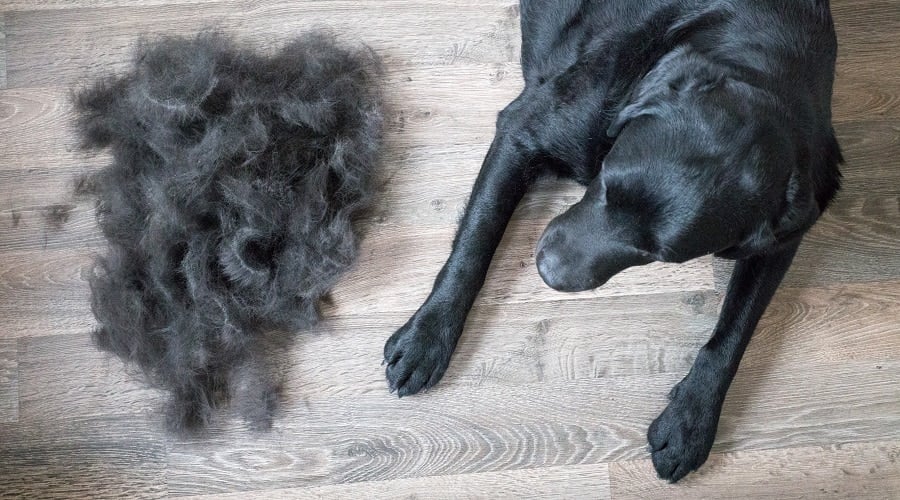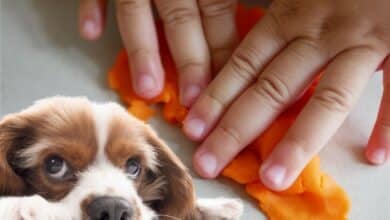Why Does My Dog Keep Scooting Its Butt Across My Floors?
When you purchase through links on our site, we may earn a commission. Here’s how it works.
Caught your dog dragging himself across that new rug in the living room? Maybe you noticed an unpleasant smell on your couch, and you aren’t sure where it’s coming from? It turns out watching your pup rubbing their butt all over the carpet or furniture isn’t just unpleasant for us pet owners!
Table of Contents
Scooting is a behavior in dogs that shouldn’t be ignored. In most cases, it can be corrected with food additions in your dog’s diet. It can also be corrected with a higher fiber dog food that can reduce impacted anal glands.
But are there other reasons why this might happen? This article discusses why dogs scoot, when to be concerned, and when to see your veterinarian. You’ll also learn about the most common treatments for scooting dogs. Let’s jump in!
What Is Scooting?
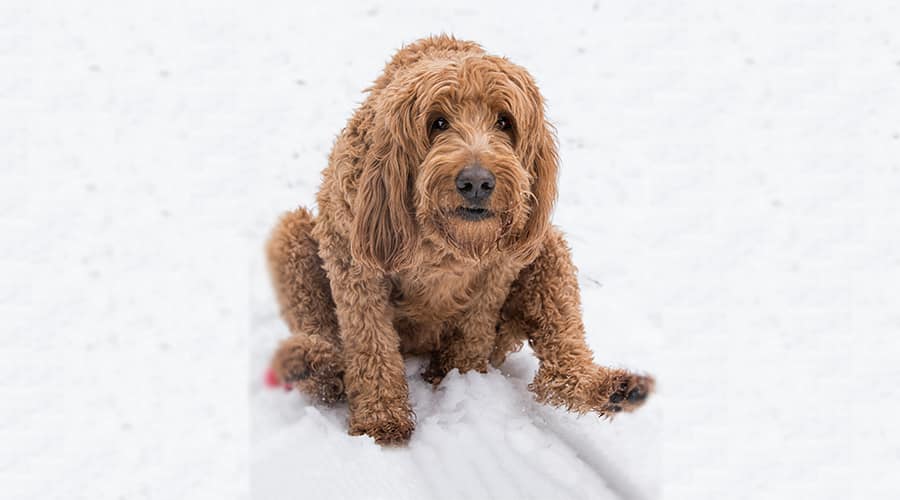
I talked to Dr. Lizzie Youens, a fellow veterinarian, about cases she sees in clinics.
“Butt scooting is a common problem for dogs – I see cases most days when I’m working in practice! When I have a scooting dog in, my first thought is usually anal glands. However, this behavior can also be caused by other factors, such as worms, skin disease or pain, so a thorough examination is always warranted.”
Dr. Lizzie Youens, Veterinarian
Scooting is when a dog drags its bottom along the floor to relieve itch, irritation, or pain. When canines scoot on the grass and carpet, it’s quite common. These types of textured surfaces help them find relief. If your canine companion is scooting repetitively and it lasts for more than a day or two, you need to book an appointment with your veterinarian to find out why.
Why Do Dogs Scoot Their Butts On The Floor Or Carpet?
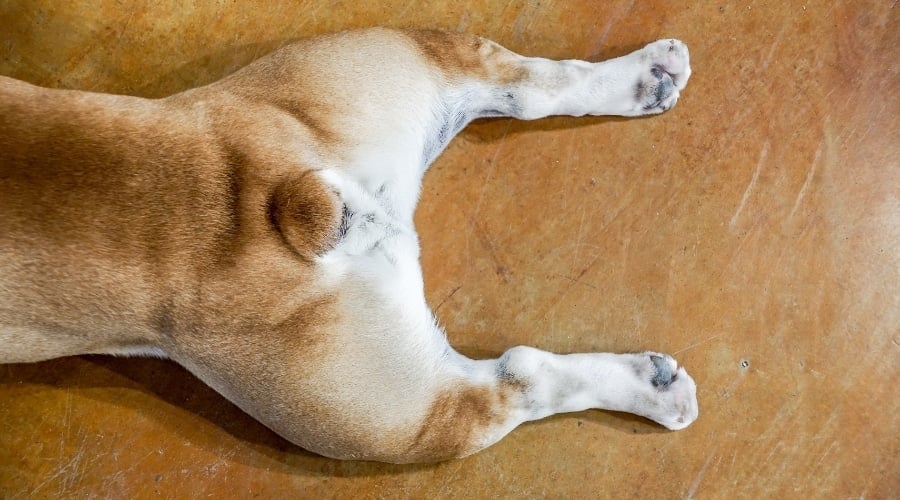
There are many reasons why dogs scoot, but it’s usually a behavioral response to relieve itching, irritation, or pain in the rear end. The most common causes include:
Anal Gland Issues
Though not a pleasant subject for most of us, dogs have two sacs located just inside their anus (bottom), known as anal glands or anal sacs. The glands lining these sacs produce a smelly brown liquid that empties naturally when your dog passes feces. This liquid plays an important role in scent communication.
Anal gland problems are the most common reason for scooting in dogs. Some dogs are unable to express their glands normally, causing them to overfill. It can also be caused by constipation. When this happens, the glands become blocked, inflamed, and uncomfortable, and Fido starts scooting to get some relief.
Dogs that have difficulty emptying their anal glands usually require regular vet visits to have their glands manually expressed. It has been suggested that dogs that are overweight or have skin allergies are more prone to having anal gland problems; however, it can happen in any dog regardless of breed.
Dogs that have had ongoing issues with diarrhea or soft stools are also more likely to end up with blocked anal glands, as passing solid stools is what empties them naturally.
If left untreated, blocked anal glands can lead to infection and even the formation of an abscess. This is extremely painful and requires urgent veterinary treatment. Other signs of anal gland issues include swelling around the anus (bottom), and excessive licking of the area. You also may notice an unpleasant ‘fishy’ odor.
If an infection or abscess has formed, this is extremely painful, and your pup may be protective of its back end or strain when passing feces. You may also notice a swelling or an open wound with bloody discharge if the abscess has burst.
Skin Irritation
Another common reason your dog might drag itself along carpet or grass is it has perianal irritation (an itchy bum!). There are many causes for irritated skin, so it’s always best to seek veterinary attention so the underlying cause can be identified and treatment prescribed. Itchy skin can quickly become infected if your dog is constantly rubbing, licking, and chewing at the area.
Dogs with skin allergies may be triggered by fleas, food ingredients, or environmental allergens. Any of these allergies may cause itchy skin around the rear end and lead to repetitive scooting behavior. Red itchy skin can also be caused by clipper rash after a haircut at the groomer.
If your canine companion has recently had diarrhea, its bottom can quickly become dirty, sore, and irritated, which may also cause them to scoot. While this provides some relief temporarily, rubbing its bottom or excessively licking only exacerbates inflammation, leading to a sore, raw bum.
Intestinal Parasites
Worms are another reason for scooting behaviors. Tapeworms, in particular, tend to cause an itchy bottom and are visible as small segments around the size of a grain of rice. You might notice these segments around your dog’s bottom or in its stool.
It’s important to ensure all your pets receive regular worming treatment to prevent them from becoming infected with intestinal worms. The common types of intestinal worms found in dogs are roundworm, hookworm, whipworm, and tapeworm.
Not only do worms steal valuable nutrients from your dog’s gut, but they can make them seriously ill, especially in small puppies. Certain species can also infect humans and are particularly dangerous to young children. Your veterinarian will be able to diagnose a worm problem and provide you with an effective treatment plan.
Pain
Any condition causing pain in the rear end may also lead to scooting. Some of the more common reasons for pain in this area include masses (lumps), a recent surgery in this area, a hernia (perineal hernia), or an anal gland abscess.
Even something as simple as matted fur can be painful if it’s pulling on the skin. Urinary incontinence can also cause urine scald or dermatitis in this area. Dogs experiencing pain may also be more protective of the area and may yelp, bite, or pull away when this area is touched.
If you think your dog is in pain, it should see a veterinarian as soon as possible.
My Dog Is Scooting. What Should I Do?
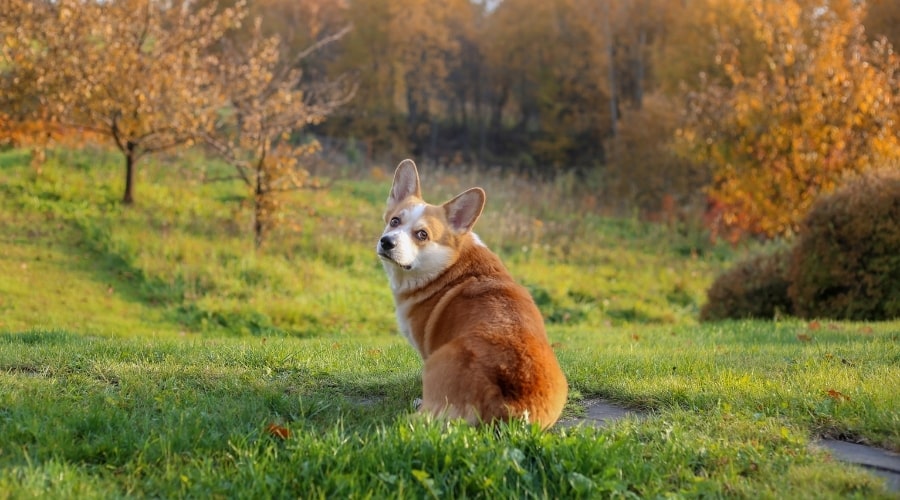
If your dog is scooting repetitively (multiple times a day) and/or the behavior continues over multiple days, it’s best to seek veterinary attention. However, it can be helpful to check a few things first if it’s safe to do so.
Examine Your Pup
If your dog will allow you to examine its bottom, you might see an obvious cause for the scooting. Do not attempt this if it appears any pain is present. Make sure another person is available to keep your pup still, as this is important for both your safety and your dog’s! Always wear gloves and wash your hands thoroughly afterward.
If your pup has a dirty bottom or matted fur, it may simply require a wash with a gentle shampoo or a clip. If you’ve never trimmed or clipped your dog’s fur, consider using a professional groomer, as it can be easy to damage the skin.
Check Their Stool
If possible, check stools for worms. Look around their bottom for tapeworm segments. However, if your dog isn’t due a poop, don’t wait. Try to remember the last time you wormed your dog and which products were used so you can tell your veterinarian.
Call Your Veterinarian
Let them know what you’ve found, your dog’s worming history, and how long you’ve seen the scooting behavior. In most cases, your veterinarian will want to examine your dog to identify the cause of the scooting so they can treat the problem and provide some relief.
Treating A Scooting Dog
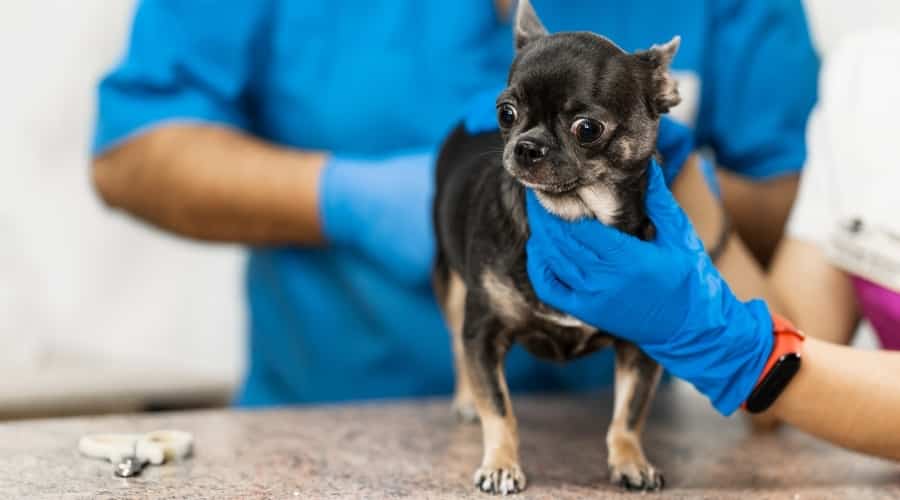
As there are many different reasons for scooting in dogs, it’s always best to have your veterinarian examine your dog so they can determine the underlying cause. This will help determine the appropriate treatment option.
Anal Gland Issues
Dogs that struggle to empty their anal glands often require regular manual expression by a veterinarian. Many groomers are also excellent at this procedure; however, your vet is also checking for abnormalities and infection when they express your dog’s anal glands.
If your dog’s anal glands are infected, or an abscess has formed, most vets will prescribe antibiotics and pain relief. In some cases, the glands may need to be drained and flushed under sedation or general anesthetic.
Feeding a high-quality diet is important as it affects your dog’s feces. Firm, well-formed stools allow the anal glands to empty naturally.
If your dog has ongoing soft stools or diarrhea, your vet may perform some tests to investigate the cause. They may also recommend a hypoallergenic diet trial to see if it has any food allergies or sensitivities.
Fiber supplementation can also be useful to ‘bulk up’ your dog’s feces. Specially designed supplements are available for dogs. Some dog owners also use home remedies such as canned pumpkin with good results. Your vet will help you with the amount of fiber to add to your pet’s diet, and any changes should always be discussed with them first.
Unfortunately, despite our best efforts, some dogs still suffer from anal gland problems that recur very frequently. In these more severe cases, surgery can be performed to remove the anal glands; however, this is a delicate procedure and should be performed by an experienced surgeon or surgical specialist.
Skin Irritation
In most cases, your vet will prescribe medication to relieve the itch or irritation. These medications may include non-steroidal anti-inflammatories (NSAIDs), corticosteroids (steroids), and other anti-itch medications (such as Apoquel or Cytopoint). Antibiotics will also be prescribed if a secondary infection is present.
For milder cases of skin irritation, your vet may prescribe a cream or specially formulated shampoo for sensitive skin. If your dog is licking the area excessively, they may need to wear an Elizabethan collar to protect them until the itch has gone.
Dogs that have recently had diarrhea may have matted fur or a dirty bottom and need to be kept clean to prevent skin irritation and dermatitis. Their back end should be washed with gentle dog shampoo and gently patted dry. If the fur is matted, it usually needs to be clipped or carefully trimmed to remove the matted fur.
If you aren’t used to clipping or trimming your dog’s fur with a pair of dog clippers, it’s best to hire a professional groomer or ask the vet to do it before you leave the clinic.
Intestinal Parasites
If worms are the cause of your dog’s scooting, your vet will prescribe an effective parasite treatment. Your vet may test their feces to diagnose a worm infection or to make sure they have been successfully eliminated after treatment.
To prevent intestinal worms, make sure to worm all of your pets regularly. Practicing good hygiene at home is also important. Make sure food and water bowls are cleaned daily and any stool is quickly picked up and disposed of safely.
Pain
If your dog is in pain, your vet will prescribe pain relief to make it more comfortable. Further treatment will depend on the source of the pain. For example, an anal gland abscess will require antibiotics and may need to be drained and flushed under general anesthesia.
Frequently Asked Questions
Why is my dog scooting?
Dogs typically scoot or drag their bottom along the floor to relieve itchiness, irritation, or pain. The most common cause for scooting in dogs is blocked or impacted anal glands. Other causes include intestinal worms, skin allergies, and dermatitis, but can include any condition that leads to pain or irritation to their back end.
Is scooting normal for dogs?
As dogs scoot to relieve itch and irritation, occasional scooting can be quite normal for dogs. However, repetitive scooting that takes place multiple times a day and/or continues for more than a day or two is usually indicative of a problem. If your dog is scooting repetitively, it needs to be checked by a vet.
How do you know if a dog has worms?
Intestinal worms may be visible in your dog’s feces, vomit, or around their bottom. Other signs include weight loss, scooting, rubbing or licking their bottom, diarrhea, vomiting, and a bloated tummy or pot-bellied appearance (especially in puppies). Some dogs may not show obvious signs of a worm burden, so it’s important to make sure they receive regular treatment as advised by your veterinarian.
How do you know if a dog needs its glands squeezed?
If your dog is scooting (dragging his bottom along the ground), swollen around his bottom, licking his bottom excessively, or you’ve noticed an unusual fishy smell, your dog may need to have his anal glands squeezed. Your vet will be able to examine and empty his glands if they need squeezing.
Can I express my dog’s glands at home?
Your dog’s glands only need to be manually expressed if they don’t empty naturally when your dog passes feces. You can learn to do this safely at home; however, you should always consult your veterinarian first, who will be able to teach you the correct method. Keep in mind your vet also checks your dog’s glands and the fluid produced for abnormalities or infection when they express them.
What can I put on my dog’s raw butt?
Contact your vet for advice before using any over-the-counter cream on your dog’s bottom. They will be able to prescribe or recommend a product that is safe to use on dogs.
Final Thoughts
Scooting is fairly normal behavior for dogs. But similar to when your dog paces excessively, it’s usually a response to pain, itching, or irritation. Dogs that are dragging their bottoms repetitively need to be seen by a veterinarian. You’ll want your vet to identify the underlying cause. This way, it can be identified and treated appropriately.
Blocked anal glands are the most common reason for scooting in dogs. Your vet will be able to express your dog’s glands in consultation and check for any other issues at the same time.
